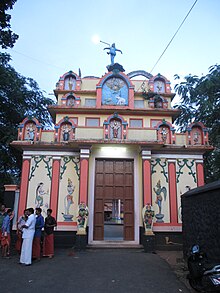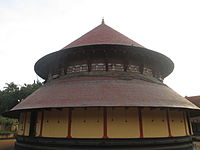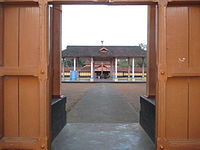Thiruvanvandoor Mahavishnu Temple: Difference between revisions
Ira Leviton (talk | contribs) m Added transliteration tags so that non-English words aren't mistaken for typos by automated spellcheckers. |
P,TO 19104 (talk | contribs) m Rollback edit(s) by Krishna995 (talk): Addition of unnecessary/inappropriate external links (RW 16.1) |
||
| (8 intermediate revisions by 7 users not shown) | |||
| Line 1: | Line 1: | ||
{{Short description|Hindu temple in Thiruvanvandoor}} |
|||
{{Use dmy dates|date=September 2019}} |
{{Use dmy dates|date=September 2019}} |
||
{{Use Indian English|date=September 2019}} |
{{Use Indian English|date=September 2019}} |
||
| Line 30: | Line 32: | ||
| website = |
| website = |
||
}} |
}} |
||
[[File:Thiruvanvandoor Pambanaiappan.png|thumb|'''Thiruvanvandoor Pambanaiappan''']] |
|||
The '''Thiruvanvandoor Mahavishnu Temple''' is a [[Hindu temple]] dedicated to [[Vishnu]] and located in [[Thiruvanvandoor]], [[Alappuzha District]], [[Kerala]], [[South India]]. Constructed in the [[Architecture of Kerala|Kerala style of architecture]], the temple is glorified in the ''[[Divya Prabandha]]'', the early medieval [[Tamil literature|Tamil]] canon of the [[Alvars| |
The '''Thiruvanvandoor Mahavishnu Temple''' is a [[Hindu temple]] dedicated to [[Vishnu]] and located in [[Thiruvanvandoor]], [[Alappuzha District]], [[Kerala]], [[South India]]. Constructed in the [[Architecture of Kerala|Kerala style of architecture]], the temple is glorified in the ''[[Divya Prabandha|Nalayira Divya Prabandham]]'', the early medieval [[Tamil literature|Tamil]] canon of the [[Alvars|Alvar]] saints from the 6th–9th centuries CE. It is one of the 108 ''[[Divyadesam|Divya Desams]]'' dedicated to [[Vishnu]], who is worshipped as Paambanaiappan. The nearest railway station to the temple is located in [[Chengannur]], while the nearest airport is [[Trivandrum International Airport]]. |
||
It is one of the five ancient shrines in the [[Chengannur]] area of Kerala, connected with the legend of [[Mahabharata]], where the five [[Pandavas]] are believed to have built one temple each; [[Thrichittatt Maha Vishnu Temple]] by [[Yudhishthira]], [[Puliyur Mahavishnu Temple]] by [[Bheema]], [[Aranmula Parthasarathy Temple]] by [[Arjuna]], Thiruvanvandoor Mahavishnu Temple by [[Nakula]] and [[Thrikodithanam Mahavishnu Temple]] by [[Sahadeva]]. |
It is one of the five ancient shrines in the [[Chengannur]] area of Kerala, connected with the legend of [[Mahabharata]], where the five [[Pandavas]] are believed to have built one temple each; [[Thrichittatt Maha Vishnu Temple]] by [[Yudhishthira]], [[Puliyur Mahavishnu Temple]] by [[Bheema]], [[Aranmula Parthasarathy Temple]] by [[Arjuna]], Thiruvanvandoor Mahavishnu Temple by [[Nakula]] and [[Thrikodithanam Mahavishnu Temple]] by [[Sahadeva]]. |
||
| Line 39: | Line 41: | ||
==Legend and history== |
==Legend and history== |
||
[[File:Thiruvanvandoor Pambanaiappan Temple 3.JPG|200px|left|thumb|Image of the tower over the sanctum sanctorum]] |
[[File:Thiruvanvandoor Pambanaiappan Temple 3.JPG|200px|left|thumb|Image of the tower over the sanctum sanctorum]] |
||
It is one of the five ancient shrines in the [[Chengannur]] area of Kerala, connected with the legend of [[Mahabharata]]. Legend has it that the [[Pandava]] princes, after crowning [[Parikshit]] as king of [[Hastinapura]] left on a pilgrimage. On arriving on the banks of river [[Pamba River|Pamba]], each one is believed to have installed a tutelary image of Krishna; [[Thrichittatt Maha Vishnu Temple]] by [[Yudhishthira]], [[Puliyur Mahavishnu Temple]] by [[Bheema]], [[Aranmula Parthasarathy Temple]] by [[Arjuna]], Thiruvanvandoor Mahavishnu Temple by [[Nakula]] and [[Thrikodithanam Mahavishnu Temple]] by [[Sahadeva]].<ref name=culture>[[#Culture|Cultural Heritage of Kerala 2008]], pp. 44-45</ref><ref name=RoaA>[[#Rao|Rao 2012]], pp. 17-20</ref> |
It is one of the five ancient shrines in the [[Chengannur]] area of Kerala, connected with the legend of [[Mahabharata]]. Legend has it that the [[Pandava]] princes, after crowning [[Parikshit]] as king of [[Hastinapura]] left on a pilgrimage. On arriving on the banks of river [[Pamba River|Pamba]], each one is believed to have installed a tutelary image of Krishna; [[Thrichittatt Maha Vishnu Temple]] by [[Yudhishthira]], [[Puliyur Mahavishnu Temple]] by [[Bheema|Bhima]], [[Aranmula Parthasarathy Temple]] by [[Arjuna]], Thiruvanvandoor Mahavishnu Temple by [[Nakula]] and [[Thrikodithanam Mahavishnu Temple]] by [[Sahadeva]].<ref name=culture>[[#Culture|Cultural Heritage of Kerala 2008]], pp. 44-45</ref><ref name=RoaA>[[#Rao|Rao 2012]], pp. 17-20</ref> |
||
The famous [[Pamba River|Pamba]] river is near the temple and hence the name of the deity is Paambanaiappan. As per another legend, the temple is believed to be consecrated by sage [[Bhrigu]]. The temple is counted as one of the five temples built and worshipped by Pandavas from [[Mahabharatha]].<ref name=gov>{{cite web|title=Chengannur Taluk|url=http://alappuzha.nic.in/pages/aboutalpy-taluk-5-chengannur.htm|publisher=Alapuzha District administration|access-date=5 August 2015}}</ref> |
The famous [[Pamba River|Pamba]] river is near the temple and hence the name of the deity is Paambanaiappan. As per another legend, the temple is believed to be consecrated by the sage [[Bhrigu]]. The temple is counted as one of the five temples built and worshipped by Pandavas from [[Mahabharatha]].<ref name=gov>{{cite web|title=Chengannur Taluk|url=http://alappuzha.nic.in/pages/aboutalpy-taluk-5-chengannur.htm|publisher=Alapuzha District administration|access-date=5 August 2015}}</ref> |
||
Earliest references to this temple appear in the poems and hymns composed by the greatest of Alvar saints - [[Nammalvar]], in circa 800 |
Earliest references to this temple appear in the poems and hymns composed by the greatest of Alvar saints - [[Nammalvar]], in circa 800 CE. Stone inscriptions in the temple date it back to the Second [[Chera dynasty|Chera]] Empire (800 - 1102 CE).<ref>Temples of Kerala. |
||
{{cite book|title=Temples of Kerala, page 304-305 |
{{cite book|title=Temples of Kerala, page 304-305 |
||
|author=S. Jayashanker, Directorate of Census Operations, Kerala (Census of India, Special Studies) |
|author=S. Jayashanker, Directorate of Census Operations, Kerala (Census of India, Special Studies) |
||
| Line 52: | Line 54: | ||
==Architecture== |
==Architecture== |
||
[[File:Thiruvanvandoor Pambanaiappan Temple 2.JPG|thumb|200px|left|View of the temple from the gateway tower]] |
[[File:Thiruvanvandoor Pambanaiappan Temple 2.JPG|thumb|200px|left|View of the temple from the gateway tower]] |
||
The temple is built in [[Architecture of Kerala|Kerala style architecture]], which is common in all temples in the South Indian state of Kerala in Eastern axis. The temple has a two storeyed [[gopuram]] or a gateway tower, with the upper |
The temple is built in [[Architecture of Kerala|Kerala style architecture]], which is common in all temples in the South Indian state of Kerala in Eastern axis. The temple has a two storeyed [[gopuram]] or a gateway tower, with the upper story having wooden trails covering the ''Kottupura'' (a hall of drum beating during festivals). A rectangular wall around the temple, called ''Kshetra-Madilluka'' pierced by the gateways, encloses all the shrines of the temple. The metal plated flagpost or ''[[Dwajasthambam|dvajasthambam]]'' is located axial to the temple tower leading to the central sanctum and there is a ''Deepastamba'', which is the light post. ''Chuttuambalam'' is the outer pavilion within the temple walls. The central shrine and the associated hall is located in a rectangular structure called ''Nallambalam'', which has pillared halls and corridors.<ref name=RoaB>[[#Rao|Rao 2012]], pp. 12-13</ref> Between the entrance of ''Nallambalam'' to the sanctum, there is a raised square platform called ''Namaskara Mandapa'' which has a pyramidal roof. ''Thevrapura'', the kitchen used to cook offering to the deity is located on the left of ''Namaskara Mandapa'' from the entrance. ''Balithara'' is an altar is used for making ritualistic offering to demi-gods and the festive deities. The central shrine called ''Sreekovil'' houses the image of the presiding deity. It is on an elevated platform with a single door reached through a flight of five steps. Either sides of the doors have images of guardian deities called [[dvarapala]]kas. As per Kerala rituals, only the main priest called [[Thantri]] and the second priest called [[Melshanthi]] alone can enter the ''Sree Kovil''.<ref>[[#Culture|Cultural Heritage of Kerala 2008]], p. 139</ref> The central shrine has a circular plan with the base built of granite, superstructure built of laterite and conical roof made of terracata tile supported from inside by a wooden structure. The lower half of ''Sree Kovil'' consists of the basement, the pillar or the wall, called {{transl|hi|stambha}} or {{transl|hi|bhithi}} and the entablature called {{transl|hi|prasthara}} in the ratio 1:2:1, in height. Similarly the upper half is divided into the neck called {{transl|hi|griva}}, the roof tower called {{transl|hi|shikhara}} and the conical {{transl|hi|kalasam}} (made of copper) in the same ratio. The roof projects in two levels to protect the inner structure from heavy rains during monsoon. The roof of the temple and some of the pillars have lavish wood and stucco carvings depicting various stories of ancient epics, [[Ramayana]] and [[Mahabharatha|Mahabharata]].<ref>{{cite book|title=The Indian Encyclopaedia: Kamli-Kyouk Phyu|editor=Subodh Kapoor|page=3963|publisher=Genesis Publishing Pvt Ltd|year=2002|isbn=9788177552577|volume=13|url=https://books.google.com/books?id=AYN0n0pzlpcC&q=kerala+temple+architecture&pg=PA3963}}</ref> The outer walls around the sanctum have a series of wooden frames housing an array of lamps, which are lit during festive occasions.<ref>{{cite journal|title=The Architecture and Organization of Kerala Style Hindu Temples|jstor=40460291|page=17|last=Noble|first=William A.|journal=Anthropos|year=1981|volume=76|issue=1/2|issn=0257-9774}}</ref> The temples have paintings on its walls dating back to early 18 century.<ref name=culture23>[[#Culture|Cultural Heritage of Kerala 2008]], p. 151</ref> |
||
==Festival== |
==Festival== |
||
The annual |
The annual [[Tiruvaymoli]] festival is celebrated in commemoration of [[Nammazhwar|Nammalvar]], the saint poet of 8th century.<ref name=gov/> The annual 51-day festival to commemorate the installation of idol of Sreekrishna is concluded with Gajamela, where a parade of 21 caparisoned elephants is held. The floats depict depicting Puranic themes and are accompanied by music players playing Mayuranrithom, Krishnanattom, Karakom, Nadaswarom, Panchavadyam, and Pancharimelom. A team of Pancharimelam performers offer rendition during the event. During the evening [[Kathakali]] performers where artiste perform various historic themes.<ref>{{cite news|title=Thiruvanvandoor temple fete concludes with Gajamela|url=http://www.thehindu.com/news/national/kerala/thiruvanvandoor-temple-fete-concludes-with-gajamela/article433769.ece|newspaper=The Hindu|access-date=22 August 2015|date=19 May 2010}}</ref><ref>{{cite news|title=Thiruvanvandoor temple fete|url=http://www.thehindu.com/todays-paper/tp-national/tp-kerala/thiruvanvandoor-temple-fete/article7225929.ece|newspaper=The Hindu|access-date=22 August 2015|date=20 May 2015}}</ref> |
||
==See also== |
==See also== |
||
| Line 61: | Line 63: | ||
==References== |
==References== |
||
;Notes |
|||
{{reflist}} |
{{reflist}} |
||
; |
|||
;Sources |
|||
| ⚫ | |||
{{refbegin}} |
|||
| ⚫ | |||
* {{cite book|title=Cultural Heritage of Kerala|url=https://books.google.com/books?id=R7QNGkZKc5wC&q=kerala+temple+architecture&pg=PA139|publisher=DC Books|location=Kerala, India|isbn=9788126419036|year=2008|ref=Culture}} |
* {{cite book |title=Cultural Heritage of Kerala |url=https://books.google.com/books?id=R7QNGkZKc5wC&q=kerala+temple+architecture&pg=PA139 |publisher=DC Books |location=Kerala, India |isbn=9788126419036 |year=2008 |ref=Culture}} |
||
* {{cite book|title=Temples of Kerala|publisher=Vasan Publications|last=Rao|first=A.V. Shankaranaryana|ref=Rao|year=2012|isbn=978-81-89888-94-7}} |
* {{cite book |title=Temples of Kerala |publisher=Vasan Publications |last=Rao |first=A.V. Shankaranaryana |ref=Rao |year=2012 |isbn=978-81-89888-94-7}} |
||
{{refend}} |
{{refend}} |
||
| ⚫ | |||
| ⚫ | |||
{{Hindu temples in Kerala}} |
{{Hindu temples in Kerala}} |
||
Latest revision as of 18:45, 14 June 2024
| Thiruvanvandoor Mahavishnu Temple | |
|---|---|
 | |
| Religion | |
| Affiliation | Hinduism |
| District | Alapuzha |
| Deity | Pambanaiappan (Vishnu) Gosala Krishna (Vishnu) |
| Standort | |
| Standort | Thiruvanvandoor |
| State | Kerala |
| Land | Indien |
Location in Kerala | |
| Geographic coordinates | 9°20′35″N 76°34′47″E / 9.34306°N 76.57972°E |
| Architecture | |
| Typ | Dravidian architecture |

The Thiruvanvandoor Mahavishnu Temple is a Hindu temple dedicated to Vishnu and located in Thiruvanvandoor, Alappuzha District, Kerala, South India. Constructed in the Kerala style of architecture, the temple is glorified in the Nalayira Divya Prabandham, the early medieval Tamil canon of the Alvar saints from the 6th–9th centuries CE. It is one of the 108 Divya Desams dedicated to Vishnu, who is worshipped as Paambanaiappan. The nearest railway station to the temple is located in Chengannur, while the nearest airport is Trivandrum International Airport.
It is one of the five ancient shrines in the Chengannur area of Kerala, connected with the legend of Mahabharata, where the five Pandavas are believed to have built one temple each; Thrichittatt Maha Vishnu Temple by Yudhishthira, Puliyur Mahavishnu Temple by Bheema, Aranmula Parthasarathy Temple by Arjuna, Thiruvanvandoor Mahavishnu Temple by Nakula and Thrikodithanam Mahavishnu Temple by Sahadeva.
The temple is open from 4 am to 11:00 am and 5 pm to 8 pm and is administered by Travancore Devaswom Board of the Government of Kerala.
Legend and history
[edit]
It is one of the five ancient shrines in the Chengannur area of Kerala, connected with the legend of Mahabharata. Legend has it that the Pandava princes, after crowning Parikshit as king of Hastinapura left on a pilgrimage. On arriving on the banks of river Pamba, each one is believed to have installed a tutelary image of Krishna; Thrichittatt Maha Vishnu Temple by Yudhishthira, Puliyur Mahavishnu Temple by Bhima, Aranmula Parthasarathy Temple by Arjuna, Thiruvanvandoor Mahavishnu Temple by Nakula and Thrikodithanam Mahavishnu Temple by Sahadeva.[1][2]
The famous Pamba river is near the temple and hence the name of the deity is Paambanaiappan. As per another legend, the temple is believed to be consecrated by the sage Bhrigu. The temple is counted as one of the five temples built and worshipped by Pandavas from Mahabharatha.[3]
Earliest references to this temple appear in the poems and hymns composed by the greatest of Alvar saints - Nammalvar, in circa 800 CE. Stone inscriptions in the temple date it back to the Second Chera Empire (800 - 1102 CE).[4] The temple is open from 4 am to 11:00 am and 5 pm to 8 pm and is administered by Travancore Devaswom Board of the Government of Kerala.
Architecture
[edit]
The temple is built in Kerala style architecture, which is common in all temples in the South Indian state of Kerala in Eastern axis. The temple has a two storeyed gopuram or a gateway tower, with the upper story having wooden trails covering the Kottupura (a hall of drum beating during festivals). A rectangular wall around the temple, called Kshetra-Madilluka pierced by the gateways, encloses all the shrines of the temple. The metal plated flagpost or dvajasthambam is located axial to the temple tower leading to the central sanctum and there is a Deepastamba, which is the light post. Chuttuambalam is the outer pavilion within the temple walls. The central shrine and the associated hall is located in a rectangular structure called Nallambalam, which has pillared halls and corridors.[5] Between the entrance of Nallambalam to the sanctum, there is a raised square platform called Namaskara Mandapa which has a pyramidal roof. Thevrapura, the kitchen used to cook offering to the deity is located on the left of Namaskara Mandapa from the entrance. Balithara is an altar is used for making ritualistic offering to demi-gods and the festive deities. The central shrine called Sreekovil houses the image of the presiding deity. It is on an elevated platform with a single door reached through a flight of five steps. Either sides of the doors have images of guardian deities called dvarapalakas. As per Kerala rituals, only the main priest called Thantri and the second priest called Melshanthi alone can enter the Sree Kovil.[6] The central shrine has a circular plan with the base built of granite, superstructure built of laterite and conical roof made of terracata tile supported from inside by a wooden structure. The lower half of Sree Kovil consists of the basement, the pillar or the wall, called stambha or bhithi and the entablature called prasthara in the ratio 1:2:1, in height. Similarly the upper half is divided into the neck called griva, the roof tower called shikhara and the conical kalasam (made of copper) in the same ratio. The roof projects in two levels to protect the inner structure from heavy rains during monsoon. The roof of the temple and some of the pillars have lavish wood and stucco carvings depicting various stories of ancient epics, Ramayana and Mahabharata.[7] The outer walls around the sanctum have a series of wooden frames housing an array of lamps, which are lit during festive occasions.[8] The temples have paintings on its walls dating back to early 18 century.[9]
Festival
[edit]The annual Tiruvaymoli festival is celebrated in commemoration of Nammalvar, the saint poet of 8th century.[3] The annual 51-day festival to commemorate the installation of idol of Sreekrishna is concluded with Gajamela, where a parade of 21 caparisoned elephants is held. The floats depict depicting Puranic themes and are accompanied by music players playing Mayuranrithom, Krishnanattom, Karakom, Nadaswarom, Panchavadyam, and Pancharimelom. A team of Pancharimelam performers offer rendition during the event. During the evening Kathakali performers where artiste perform various historic themes.[10][11]
See also
[edit]References
[edit]- ^ Cultural Heritage of Kerala 2008, pp. 44-45
- ^ Rao 2012, pp. 17-20
- ^ a b "Chengannur Taluk". Alapuzha District administration. Retrieved 5 August 2015.
- ^ Temples of Kerala.
S. Jayashanker, Directorate of Census Operations, Kerala (Census of India, Special Studies) (May 1997). Temples of Kerala, page 304-305.
{{cite book}}: CS1 maint: multiple names: authors list (link) - ^ Rao 2012, pp. 12-13
- ^ Cultural Heritage of Kerala 2008, p. 139
- ^ Subodh Kapoor, ed. (2002). The Indian Encyclopaedia: Kamli-Kyouk Phyu. Vol. 13. Genesis Publishing Pvt Ltd. p. 3963. ISBN 9788177552577.
- ^ Noble, William A. (1981). "The Architecture and Organization of Kerala Style Hindu Temples". Anthropos. 76 (1/2): 17. ISSN 0257-9774. JSTOR 40460291.
- ^ Cultural Heritage of Kerala 2008, p. 151
- ^ "Thiruvanvandoor temple fete concludes with Gajamela". The Hindu. 19 May 2010. Retrieved 22 August 2015.
- ^ "Thiruvanvandoor temple fete". The Hindu. 20 May 2015. Retrieved 22 August 2015.
External links
[edit]- Cultural Heritage of Kerala. Kerala, India: DC Books. 2008. ISBN 9788126419036.
- Rao, A.V. Shankaranaryana (2012). Temples of Kerala. Vasan Publications. ISBN 978-81-89888-94-7.

